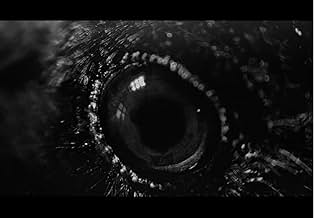The dark fantasy love story of legendary Japanese photographer Masahisa Fukase and his wife Yoko.The dark fantasy love story of legendary Japanese photographer Masahisa Fukase and his wife Yoko.The dark fantasy love story of legendary Japanese photographer Masahisa Fukase and his wife Yoko.
- Awards
- 1 win & 1 nomination total
- Director
- Writer
- All cast & crew
- Production, box office & more at IMDbPro
Featured reviews
There's so much hyperbole surrounding anything in a society obsessed with reviews. But I really do think this is the most beautifully shot film I've ever seen. There are no throwaway shots, no fillers through coverage, just relentless beauty artfully employed in serving a complicated plot. The acting meets the cinematography, presenting a kind of restraint predictable for a Japan-set film but doing so in a way that allows the emotion to resonate throughout. Mark Gill, the director, took a lot of artistic risks in how he presented the story of this famed, troubled photographer, and they pretty much all paid off.
Rating - 7.6:
Overall, a pretty good biopic on Japanese photographer Masahisa Fukase, as the film is a polished execution depicting the tortured artist; but the scenes with ravens are pretty unnecessary and draw away from the storytelling.
Direction - Pretty Good: The direction on a macroscale is artistic and polished; the direction on a microscale is pretty good for the most part as the scenes between characters are really engaging, the scenes with the Raven are poorly executed and tacky; the storytelling is clear and unique, besides the raven moments
Story - Good to Very Good: The concept is good as it goes through the life of tortured photographer Masahisa Fukase; the plot structure is very good as it does a good job jumping between the past and the present to tell Fukase's story; character writing is good as they do a good job painting Masahisa Fukase as this troubled artist and how those around him are effected by it but the writing for the Raven is pretty bad
Screenplay - Good: The dialogue is polished and profound, but the English dialogue for the Raven was not good and unnecessary; the humor is present and helps lighten the tone; the symbolism is very profound as the Raven symbolizes the darkness for the protagonist, but these aspects for the movie were not that well executed; the foreshadowing is profound as the plot structure for the movie really heightens the importance of foreshadowing to tell the story
Acting - Pretty Good: Tadanobu Asano - Good (Really immerses himself in the role, as he shows how the protagonist is a tortured artist), Sôsuke Ikematsu - Decent to Pretty Good (Supports Asano as well as his apprentice/assistant, but really is not given that much material to work with on his own), Kumi Takiuchi - Pretty Good (Plays a supporting role well with Asano, as the two have good chemistry), Kanji Furutachi - Decent to Pretty Good (Shows the distance between the father and son in the movie well, as he helps create tension with his scenes with Asano), Rest of the cast - Decent (Supports the main cast well; the action from the raven was not that great as their scenes felt very forced due to the lack of chemistry)
Score - Pretty Good: Helped give the movie an artsy feel
Cinematography - Pretty Good: Polished and well-executed; it feels like it is from the perspective of a photographer/camera
Editing - Pretty Good: "Polished and well-executed", seamlessly shows the photos from the photographer
Visual Effects - Pretty Bad: Pretty tacky with how it incorporates the raven
Pacing - Pacing is fine, as the slower pace helps you sit with and get to know these characters
Climax - The climax is executed well
Tone - Tone feels like an artsy biopic
Final Notes - I saw the world premiere at the Austin Film Festival.
Direction - Pretty Good: The direction on a macroscale is artistic and polished; the direction on a microscale is pretty good for the most part as the scenes between characters are really engaging, the scenes with the Raven are poorly executed and tacky; the storytelling is clear and unique, besides the raven moments
Story - Good to Very Good: The concept is good as it goes through the life of tortured photographer Masahisa Fukase; the plot structure is very good as it does a good job jumping between the past and the present to tell Fukase's story; character writing is good as they do a good job painting Masahisa Fukase as this troubled artist and how those around him are effected by it but the writing for the Raven is pretty bad
Screenplay - Good: The dialogue is polished and profound, but the English dialogue for the Raven was not good and unnecessary; the humor is present and helps lighten the tone; the symbolism is very profound as the Raven symbolizes the darkness for the protagonist, but these aspects for the movie were not that well executed; the foreshadowing is profound as the plot structure for the movie really heightens the importance of foreshadowing to tell the story
Acting - Pretty Good: Tadanobu Asano - Good (Really immerses himself in the role, as he shows how the protagonist is a tortured artist), Sôsuke Ikematsu - Decent to Pretty Good (Supports Asano as well as his apprentice/assistant, but really is not given that much material to work with on his own), Kumi Takiuchi - Pretty Good (Plays a supporting role well with Asano, as the two have good chemistry), Kanji Furutachi - Decent to Pretty Good (Shows the distance between the father and son in the movie well, as he helps create tension with his scenes with Asano), Rest of the cast - Decent (Supports the main cast well; the action from the raven was not that great as their scenes felt very forced due to the lack of chemistry)
Score - Pretty Good: Helped give the movie an artsy feel
Cinematography - Pretty Good: Polished and well-executed; it feels like it is from the perspective of a photographer/camera
Editing - Pretty Good: "Polished and well-executed", seamlessly shows the photos from the photographer
Visual Effects - Pretty Bad: Pretty tacky with how it incorporates the raven
Pacing - Pacing is fine, as the slower pace helps you sit with and get to know these characters
Climax - The climax is executed well
Tone - Tone feels like an artsy biopic
Final Notes - I saw the world premiere at the Austin Film Festival.
I am privileged to say I was amongst the first people in the world to see Ravens be premiered at the Austin Film Festival. This film was unequivocally one of the best of the decade, Mark Gill truly showed his love for Japanese film and cemented himself as one of the best directors of the year.
To start off, the most striking thing was the screenplay. As an art history student, I was always familiar with Masahisa Fukase. The screenplay did a wonderful job of at interconnecting his personal life and the growth of his art. The writing focused more on the characterization of Masahisa and his wife instead of following the traditional linear structure of the West - which is my opinion was the best thing they could've done. The non-linear almost psychodynamic scenes that broke the structure truly encapsulated the torment of Masahisa's mind and made the manifestation of the actual Raven more believable in the world that was created.
The writing of the Raven itself - a physical manifestation of Masahisa's mind was done with masterful intent. The Raven's dialogue- always mocking and condescending was believable, the worlds masterfully mimicked the mind of a doubtful artist. Even the ending scene, the choice to not end with Masahisa's art or the world after his death but his demise itself as he was no longer able to make his art was rewarding.
The cinematography is also what puts this film one step above the rest. The striking juxtaposition of warm and cold visuals were evocative of modern Japanese films. The camera work, specifically during scenes of drug and alcohol use were wonderful - the camera physically acted as his distorted mind. The color grading gradually becoming more cold as his marriage progresses was peak visual storytelling. The scenes in the flashbacks, the natural sunlight always on Will in her youth was so comforting. I will go as far to argue that next to Anora, the color grading/cinematography of Ravens is the only competitor. In a world of Airbnb colored films, this world was as artfully colored as Fukase's mind.
I urge anyone with the opportunity to go and see this film. This film checks all the marks for what Western filmmaking is currently missing and why films like The Brutalist and Blitz could run for hours but the emotional connection to the audience will never be enough. Film is the medium, the screenplay is the foundation and this film does a wonderful job at knowing when to break the traditional conventions of both.
To start off, the most striking thing was the screenplay. As an art history student, I was always familiar with Masahisa Fukase. The screenplay did a wonderful job of at interconnecting his personal life and the growth of his art. The writing focused more on the characterization of Masahisa and his wife instead of following the traditional linear structure of the West - which is my opinion was the best thing they could've done. The non-linear almost psychodynamic scenes that broke the structure truly encapsulated the torment of Masahisa's mind and made the manifestation of the actual Raven more believable in the world that was created.
The writing of the Raven itself - a physical manifestation of Masahisa's mind was done with masterful intent. The Raven's dialogue- always mocking and condescending was believable, the worlds masterfully mimicked the mind of a doubtful artist. Even the ending scene, the choice to not end with Masahisa's art or the world after his death but his demise itself as he was no longer able to make his art was rewarding.
The cinematography is also what puts this film one step above the rest. The striking juxtaposition of warm and cold visuals were evocative of modern Japanese films. The camera work, specifically during scenes of drug and alcohol use were wonderful - the camera physically acted as his distorted mind. The color grading gradually becoming more cold as his marriage progresses was peak visual storytelling. The scenes in the flashbacks, the natural sunlight always on Will in her youth was so comforting. I will go as far to argue that next to Anora, the color grading/cinematography of Ravens is the only competitor. In a world of Airbnb colored films, this world was as artfully colored as Fukase's mind.
I urge anyone with the opportunity to go and see this film. This film checks all the marks for what Western filmmaking is currently missing and why films like The Brutalist and Blitz could run for hours but the emotional connection to the audience will never be enough. Film is the medium, the screenplay is the foundation and this film does a wonderful job at knowing when to break the traditional conventions of both.
Details
- Runtime1 hour 57 minutes
- Color
- Aspect ratio
- 2.35 : 1
Contribute to this page
Suggest an edit or add missing content
























